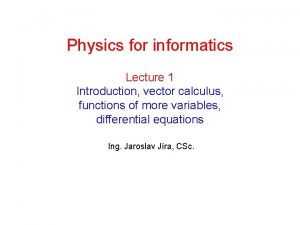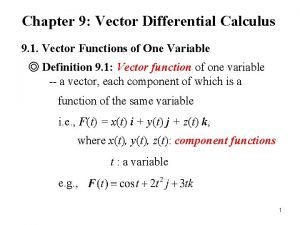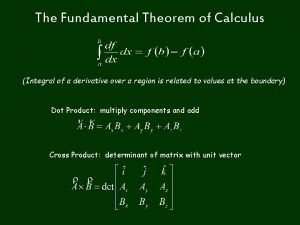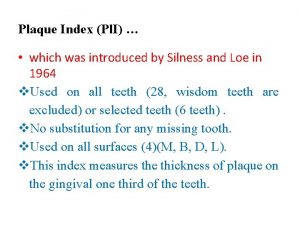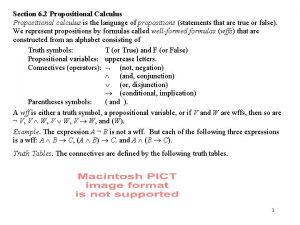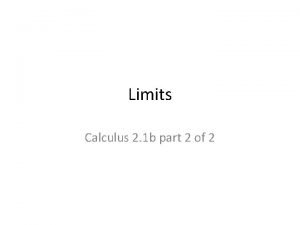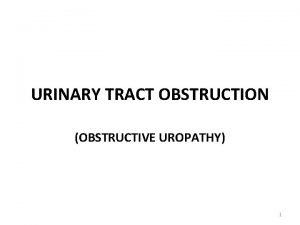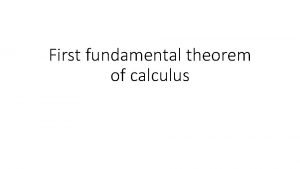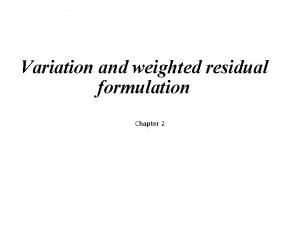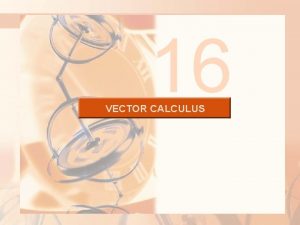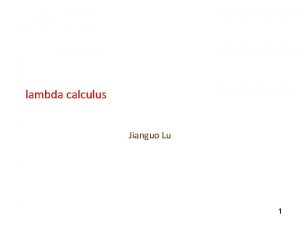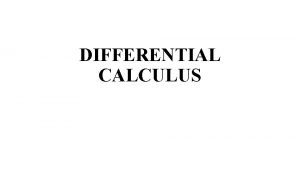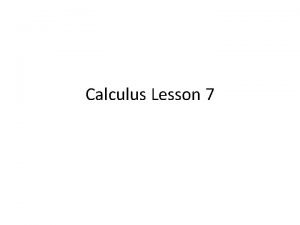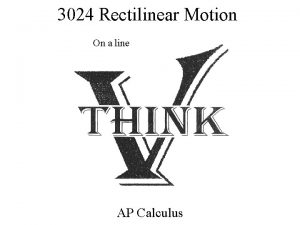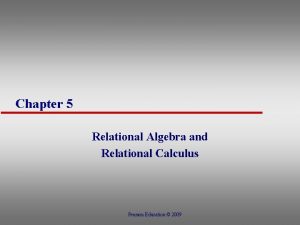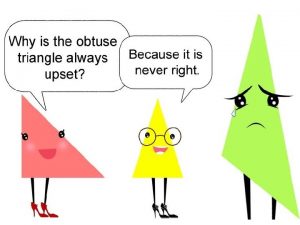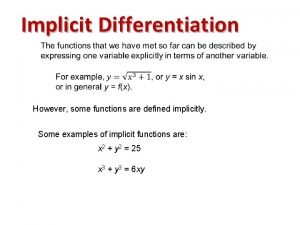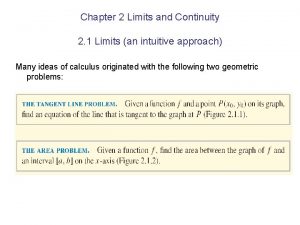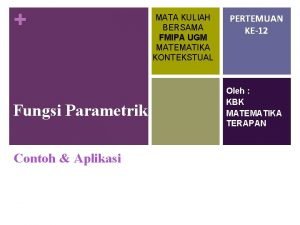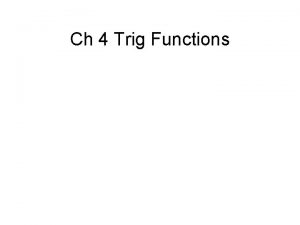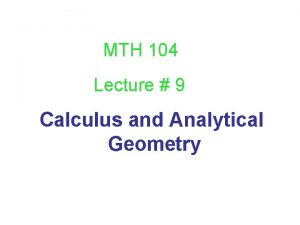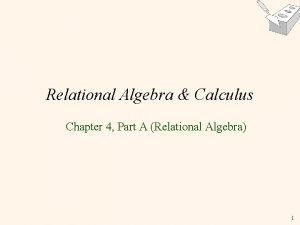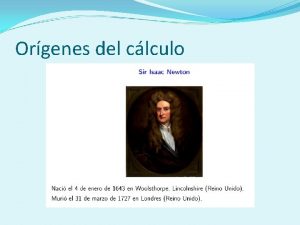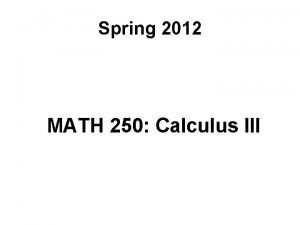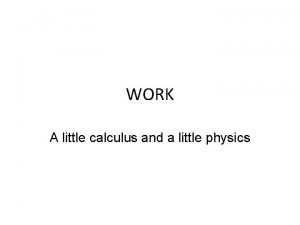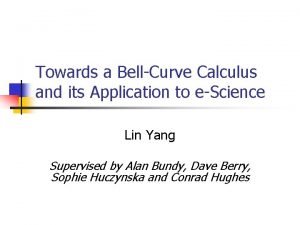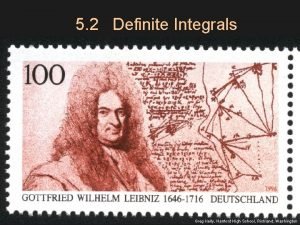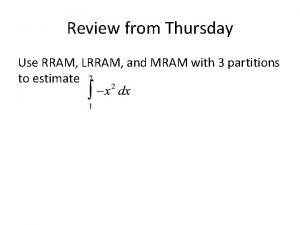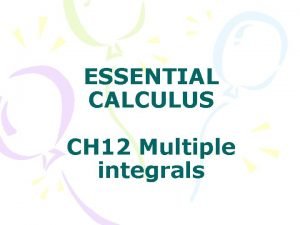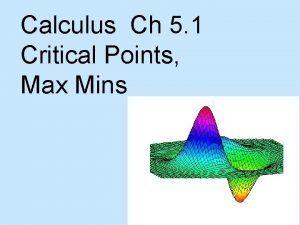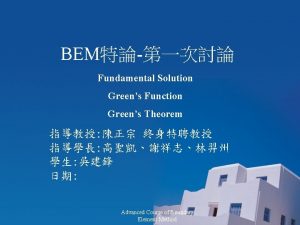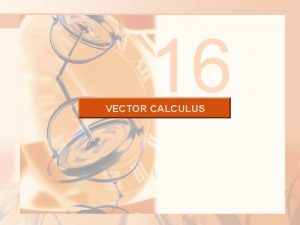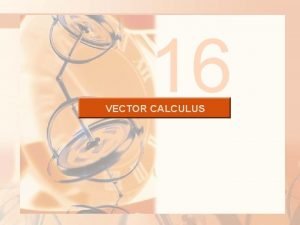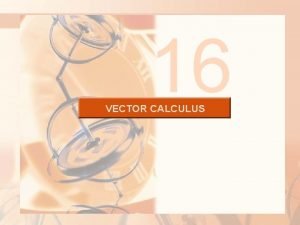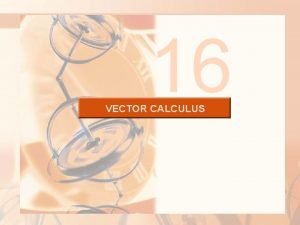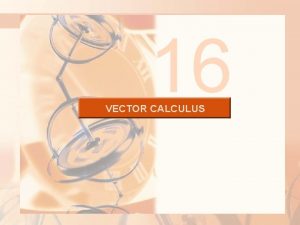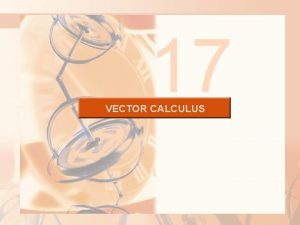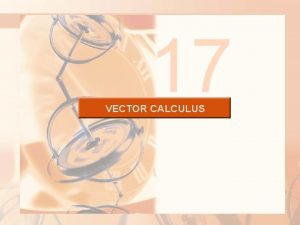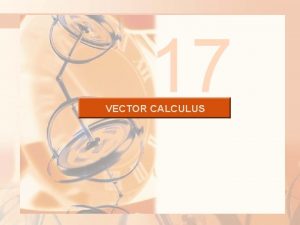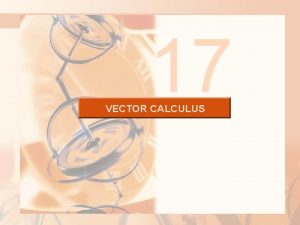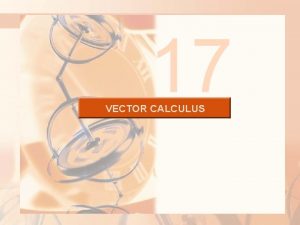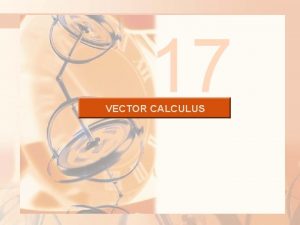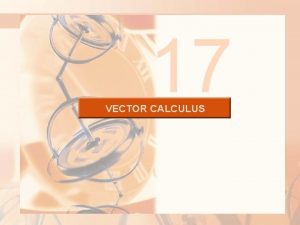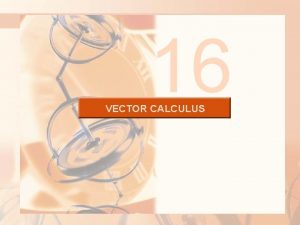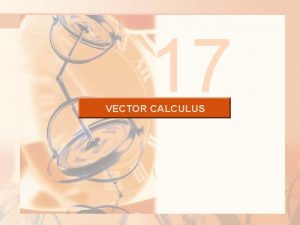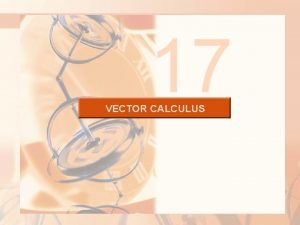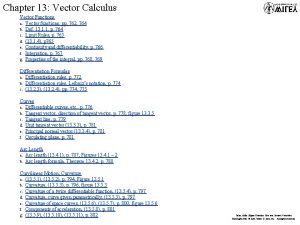16 VECTOR CALCULUS VECTOR CALCULUS 16 4 Greens










![GREEN’S THEOREM In the one-dimensional case, the domain is an interval [a, b] whose GREEN’S THEOREM In the one-dimensional case, the domain is an interval [a, b] whose](https://slidetodoc.com/presentation_image_h/eda292769c1b2344018fc52ab7fb82d7/image-11.jpg)




















































- Slides: 63

16 VECTOR CALCULUS

VECTOR CALCULUS 16. 4 Green’s Theorem In this section, we will learn about: Green’s Theorem for various regions and its application in evaluating a line integral.

INTRODUCTION Green’s Theorem gives the relationship between a line integral around a simple closed curve C and a double integral over the plane region D bounded by C. § We assume that D consists of all points inside C as well as all points on C.

INTRODUCTION In stating Green’s Theorem, we use the convention: § The positive orientation of a simple closed curve C refers to a single counterclockwise traversal of C.

INTRODUCTION Thus, if C is given by the vector function r(t), a ≤ t ≤ b, then the region D is always on the left as the point r(t) traverses C.

GREEN’S THEOREM Let C be a positively oriented, piecewisesmooth, simple closed curve in the plane and let D be the region bounded by C. § If P and Q have continuous partial derivatives on an open region that contains D, then

NOTATIONS Note The notation is sometimes used to indicate that the line integral is calculated using the positive orientation of the closed curve C.

NOTATIONS Note—Equation 1 Another notation for the positively oriented boundary curve of D is ∂D. So, the equation in Green’s Theorem can be written as:

GREEN’S THEOREM Green’s Theorem should be regarded as the counterpart of the Fundamental Theorem of Calculus (FTC) for double integrals.

GREEN’S THEOREM Compare Equation 1 with the statement of the FTC Part 2 (FTC 2), in this equation: In both cases, § There is an integral involving derivatives (F’, ∂Q/∂x, and ∂P/∂y) on the left side. § The right side involves the values of the original functions (F, Q, and P) only on the boundary of the domain.
![GREENS THEOREM In the onedimensional case the domain is an interval a b whose GREEN’S THEOREM In the one-dimensional case, the domain is an interval [a, b] whose](https://slidetodoc.com/presentation_image_h/eda292769c1b2344018fc52ab7fb82d7/image-11.jpg)
GREEN’S THEOREM In the one-dimensional case, the domain is an interval [a, b] whose boundary consists of just two points, a and b.

SIMPLE REGION The theorem is not easy to prove in general. Still, we can give a proof for the special case where the region is both of type I and type II (Section 15. 3). § Let’s call such regions simple regions.

GREEN’S TH. (SIMPLE REGION) Proof—Eqns. 2 & 3 Notice that theorem will be proved if we can show that: and

GREEN’S TH. (SIMPLE REGION) Proof We prove Equation 2 by expressing D as a type I region: D = {(x, y) | a ≤ x ≤ b, g 1(x) ≤ y ≤ g 2(x)} where g 1 and g 2 are continuous functions.

GREEN’S TH. (SIMPLE REGION) Proof—Equations 4 That enables us to compute the double integral on the right side of Equation 2 as: where the last step follows from the FTC.

GREEN’S TH. (SIMPLE REGION) Proof Now, we compute the left side of Equation 2 by breaking up C as the union of the four curves C 1, C 2, C 3, and C 4.

GREEN’S TH. (SIMPLE REGION) Proof On C 1 we take x as the parameter and write the parametric equations as: x = x, y = g 1(x), a ≤ x ≤ b § Thus,

GREEN’S TH. (SIMPLE REGION) Proof Observe that C 3 goes from right to left but –C 3 goes from left to right.

GREEN’S TH. (SIMPLE REGION) Proof So, we can write the parametric equations of –C 3 as: x = x, y = g 2(x), a ≤ x ≤ b § Therefore,

GREEN’S TH. (SIMPLE REGION) Proof On C 2 or C 4 (either of which might reduce to just a single point), x is constant. § So, dx = 0 and

GREEN’S TH. (SIMPLE REGION) Hence, Proof

GREEN’S TH. (SIMPLE REGION) Proof Comparing this expression with the one in Equation 4, we see that:

GREEN’S TH. (SIMPLE REGION) Proof Equation 3 can be proved in much the same way by expressing D as a type II region. § Then, by adding Equations 2 and 3, we obtain Green’s Theorem. § See Exercise 28.

GREEN’S THEOREM Example 1 Evaluate where C is the triangular curve consisting of the line segments from (0, 0) to (1, 0) from (1, 0) to (0, 1) from (0, 1) to (0, 0)

GREEN’S THEOREM Example 1 The given line integral could be evaluated as usual by the methods of Section 16. 2. § However, that would involve setting up three separate integrals along the three sides of the triangle. § So, let’s use Green’s Theorem instead.

GREEN’S TH. (SIMPLE REGION) Example 1 Notice that the region D enclosed by C is simple and C has positive orientation.

GREEN’S TH. (SIMPLE REGION) Example 1 If we let P(x, y) = x 4 and Q(x, y) = xy, then

GREEN’S THEOREM Example 2 Evaluate where C is the circle x 2 + y 2 = 9. § The region D bounded by C is the disk x 2 + y 2 ≤ 9.

GREEN’S THEOREM Example 2 § So, let’s change to polar coordinates after applying Green’s Theorem:

GREEN’S THEOREM In Examples 1 and 2, we found that the double integral was easier to evaluate than the line integral. § Try setting up the line integral in Example 2 and you’ll soon be convinced!

REVERSE DIRECTION Sometimes, though, it’s easier to evaluate the line integral, and Green’s Theorem is used in the reverse direction. § For instance, if it is known that P(x, y) = Q(x, y) = 0 on the curve C, theorem gives: no matter what values P and Q assume in D.

REVERSE DIRECTION Another application of the reverse direction of theorem is in computing areas. As the area of D is P and Q so that: , we wish to choose

REVERSE DIRECTION There are several possibilities: § § § P(x, y) = 0 P(x, y) = –y P(x, y) = –½y Q(x, y) = x Q(x, y) = 0 Q(x, y) = ½x

REVERSE DIRECTION Equation 5 Then, Green’s Theorem gives the following formulas for the area of D:

REVERSE DIRECTION Example 3 Find the area enclosed by the ellipse § The ellipse has parametric equations x = a cos t, y = b sin t, 0 ≤ t ≤ 2π

REVERSE DIRECTION Example 3 § Using the third formula in Equation 5, we have:

UNION OF SIMPLE REGIONS We have proved Green’s Theorem only for the case where D is simple. Still, we can now extend it to the case where D is a finite union of simple regions.

UNION OF SIMPLE REGIONS For example, if D is the region shown here, we can write: D = D 1 where D 1 and D 2 are both simple. D 2

UNION OF SIMPLE REGIONS The boundary of D 1 is C 1 C 3. The boundary of D 2 is C 2 (–C 3).

UNION OF SIMPLE REGIONS So, applying Green’s Theorem to D 1 and D 2 separately, we get:

UNION OF SIMPLE REGIONS If we add these two equations, the line integrals along C 3 and –C 3 cancel. So, we get: § Its boundary is C = C 1 C 2. § Thus, this is Green’s Theorem for D = D 1 D 2.

UNION OF NONOVERLAPPING SIMPLE REGIONS The same sort of argument allows us to establish Green’s Theorem for any finite union of nonoverlapping simple regions.

UNION OF SIMPLE REGIONS Example 4 Evaluate where C is the boundary of the semiannular region D in the upper half-plane between the circles x 2 + y 2 = 1 and x 2 + y 2 = 4.

UNION OF SIMPLE REGIONS Example 4 Notice that, though D is not simple, the y-axis divides it into two simple regions. § In polar coordinates, we can write: D = {(r, θ) | 1 ≤ r ≤ 2, 0 ≤ θ ≤π}

UNION OF SIMPLE REGIONS So, Green’s Theorem gives: Example 4

REGIONS WITH HOLES Green’s Theorem can be extended to regions with holes—that is, regions that are not simply-connected.

REGIONS WITH HOLES Observe that the boundary C of the region D here consists of two simple closed curves C 1 and C 2.

REGIONS WITH HOLES We assume that these boundary curves are oriented so that the region D is always on the left as the curve C is traversed. § So, the positive direction is counterclockwise for C 1 but clockwise for C 2.

REGIONS WITH HOLES Let’s divide D into two regions D’ and D” by means of the lines shown here.

REGIONS WITH HOLES Then, applying Green’s Theorem to each of D’ and D” , we get: § As the line integrals along the common boundary lines are in opposite directions, they cancel.

REGIONS WITH HOLES Thus, we get: § This is Green’s Theorem for the region D.

REGIONS WITH HOLES If show that Example 5 F(x, y) = (–y i + x j)/(x 2 + y 2) ∫C F · dr = 2π for every positively oriented, simple closed path that encloses the origin.

REGIONS WITH HOLES Example 5 C is an arbitrary closed path that encloses the origin. Thus, it’s difficult to compute the given integral directly.

REGIONS WITH HOLES Example 5 So, let’s consider a counterclockwise-oriented circle C’ with center the origin and radius a, where a is chosen to be small enough that C’ lies inside C.

REGIONS WITH HOLES Example 5 Let D be the region bounded by C and C’. § Then, its positively oriented boundary is C (–C’).

REGIONS WITH HOLES Example 5 So, the general version of Green’s Theorem gives:

REGIONS WITH HOLES Example 5 Therefore, That is, § We now easily compute this last integral using the parametrization given by: r(t) = a cos t i + a sin t j, 0 ≤ t ≤ 2π

REGIONS WITH HOLES Thus, Example 5

GREEN’S THEOREM We end by using Green’s Theorem to discuss a result that was stated in Section 16. 3

THEOREM 6 IN SECTION 16. 3 Proof We’re assuming that: § F = P i + Q j is a vector field on an open simply-connected region D. § P and Q have continuous first-order partial derivatives. § throughout D

THEOREM 6 IN SECTION 16. 3 Proof If C is any simple closed path in D and R is the region that C encloses, Green’s Theorem gives:

THEOREM 6 IN SECTION 16. 3 Proof A curve that is not simple crosses itself at one or more points and can be broken up into a number of simple curves. § We have shown that the line integrals of F around these simple curves are all 0. § Adding these integrals, we see that ∫C F · dr = 0 for any closed curve C.

THEOREM 6 IN SECTION 16. 3 Proof Thus, ∫C F · dr is independent of path in D by Theorem 3 in Section 16. 3. It follows that F is a conservative vector field.
 Difference between stokes theorem and green's theorem
Difference between stokes theorem and green's theorem Green's theorem
Green's theorem Emerald ash borer nj
Emerald ash borer nj Katherine pike
Katherine pike Post harvest handling of cut flowers and greens
Post harvest handling of cut flowers and greens Forever fields of greens benefits
Forever fields of greens benefits Bermuda grass golf greens
Bermuda grass golf greens Carbohydrate digestion
Carbohydrate digestion Examples of vitamins
Examples of vitamins Doc greens menu
Doc greens menu Vector identities
Vector identities Divergence de gradient
Divergence de gradient Fundamental theorem of vector calculus
Fundamental theorem of vector calculus Vector differentiation
Vector differentiation Vector resolution examples
Vector resolution examples What is fixed vector
What is fixed vector Vector resultante
Vector resultante Vector properties
Vector properties Calculus
Calculus Stewart calculus chapter 11
Stewart calculus chapter 11 Calculus
Calculus Calculus bridge
Calculus bridge Shell method calculus formula
Shell method calculus formula Calculus chapter 5
Calculus chapter 5 30 rates
30 rates Calculus teeth
Calculus teeth Propositional calculus
Propositional calculus Calculus 2 limits
Calculus 2 limits Staghorn calculus
Staghorn calculus Calculus examples
Calculus examples Variational calculus
Variational calculus Curl calculus
Curl calculus Calculus
Calculus Integral by parts
Integral by parts Calculus
Calculus Derivative of abc
Derivative of abc Tijdscomplexiteit
Tijdscomplexiteit Rectilinear motion calculus
Rectilinear motion calculus Elsa lambda calculus
Elsa lambda calculus Predicate calculus in ai
Predicate calculus in ai Relational algebra and relational calculus
Relational algebra and relational calculus History of calculus
History of calculus Differentiation of implicit function
Differentiation of implicit function Chapter 2 limits and continuity
Chapter 2 limits and continuity Episikloida
Episikloida All students take calculus
All students take calculus Mth 104
Mth 104 Functional ito calculus
Functional ito calculus Expressive power of algebra and calculus
Expressive power of algebra and calculus Calculus dental definition
Calculus dental definition Calculus summatorius
Calculus summatorius Calculus 3
Calculus 3 Physics
Physics What's above calculus
What's above calculus Leibniz newton
Leibniz newton Curve calculus
Curve calculus Calculus bc worksheet 2 on polar
Calculus bc worksheet 2 on polar What does calculus look like
What does calculus look like Greg kelly calculus
Greg kelly calculus Precalculus honors chapter 1 test
Precalculus honors chapter 1 test Brightspace ccc
Brightspace ccc Rram lram mram
Rram lram mram Calculus chapter 12
Calculus chapter 12 Calculus critical points
Calculus critical points










